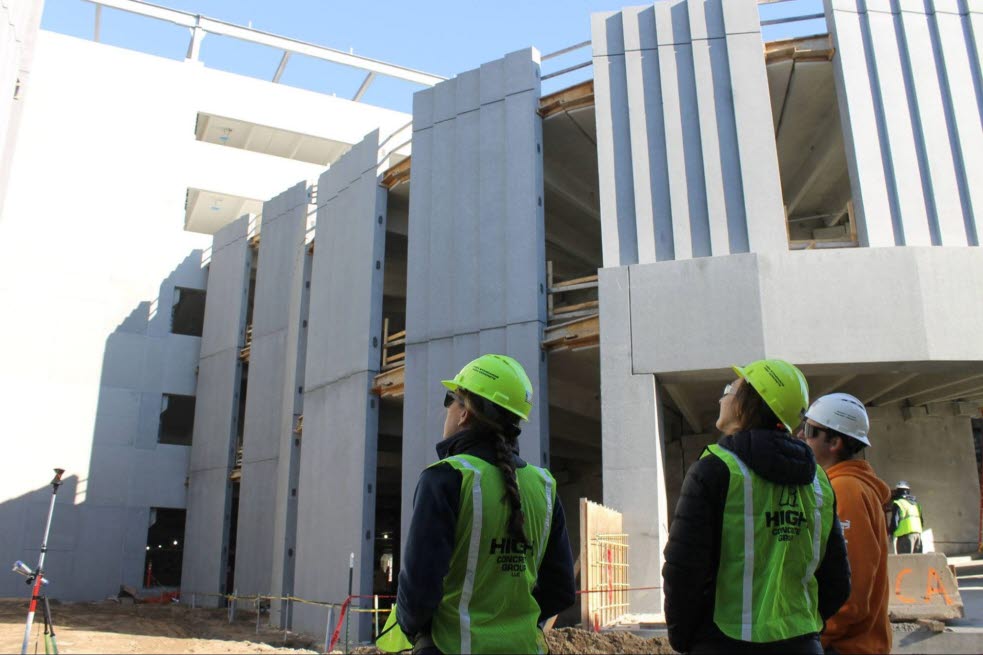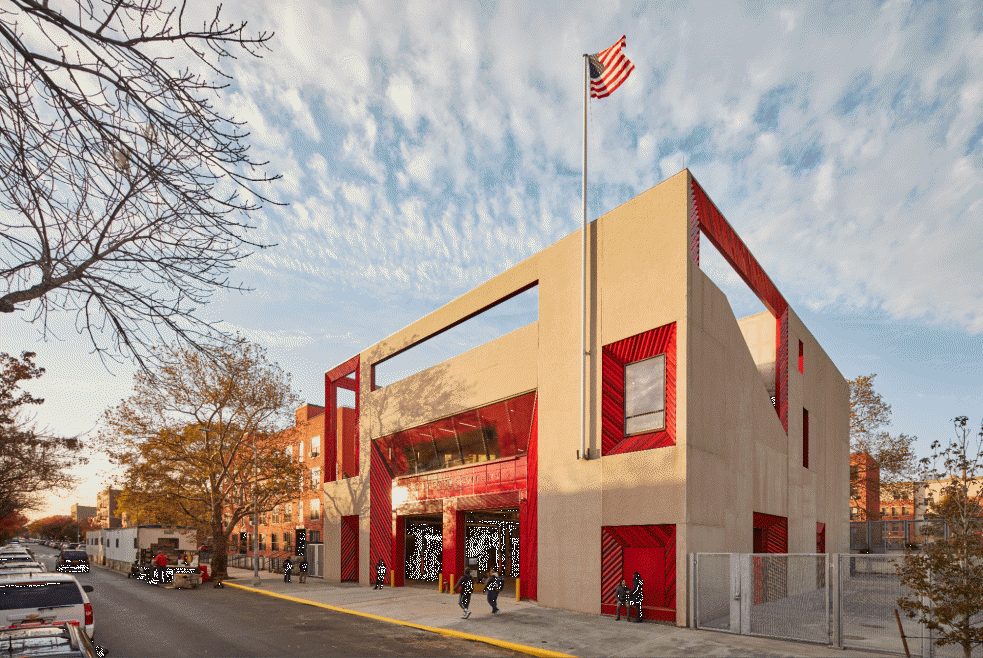4 Top Challenges in the Construction Industry & How Precast Concrete Solves Them

No matter what your role is in the construction industry, you want a smooth process and timelines met to achieve a successful project. It can be frustrating being faced with logistical challenges, weather delays, or a restricted budget.
Whether you’re looking to save costs, overcome labor shortages, or build sustainably, precast concrete can solve the top challenges in the construction industry — all without compromising your architectural creativity.
1. Limited Construction Budget
With every project, you want to make sure you are getting the most out of your construction budget. When a project budget is restricted, you may find yourself sacrificing important details of your vision.
There are a lot of moving factors on an active work site, so miscommunications and errors are probable. Common reasons a traditional construction project goes over budget is from human error or inexperience of the workforce, logistical delays, or poor communication.
Precast concrete saves you money throughout the entire construction process. Specifically, in the following ways.
Product: Due to the size of precast concrete panels, you use less building material and ultimately save money on production costs.
Transportation: As a majority of construction is done off-site, you’ll save time and money on transportation to and from the job site. Additionally, all precast concrete is produced within a certain radius of your site so you aren’t paying extra for long transportation routes.
Site Logistics: The overall impacts of construction on-site are reduced with precast concrete. You’re saving money on deliveries, crew members’ salaries, and material waste.
When you use precast concrete as your building material, you’ll notice the breakdown of costs allocates less for transportation and site logistics and more for your physical project.
Even though a small portion of your precast concrete construction budget is allocated to finishing, your options are practically limitless. You are able to customize the exterior facade to match your brand’s style. There is even the possibility to add text, symbols, or logos to your precast concrete building.
There are also long-term cost benefits that are associated with precast concrete. Because of the thermal efficiency of this building material, you’ll save costs on your HVAC systems. Additionally, built-in insulation helps reduce the costs of extra steps and extra workforce during the construction process.
Your construction budget includes more than just the physical building, so it’s crucial to save money where you can. The Christ Hospital Joint & Spine Center highlights the financial benefit of using precast concrete. The total budget for the building was $280 million, and the total precast concrete cost was $7.1 million, or only 2% of the total budget.
2. Construction Shortages
Whether you’re looking at construction labor shortages or material shortages, both will cause turmoil in your building process. It becomes very frustrating when projects can’t be completed because of aspects you can’t control.
Labor
The construction labor shortage is nothing new but has taken a drastic toll during the last couple of years. As the industry continues to get older, more and more of the workforce is entering retirement age.
The generation entering the workforce is looking past the construction industry due to inconsistent schedules and demanding labor. In 2021, the Associated Builders and Contractors estimated that the construction industry needed 430,000 additional workers. As of 2022, the shortage increased to 650,000.
Precast concrete solves this major problem in the construction industry. A smaller crew is needed for precast concrete since a majority of the construction is completed off-site. With a smaller crew, it also means there are fewer trades to train for within a precast concrete setting.
Additionally, in a precast concrete setting, each worker is specialized in their field. Precasters aren’t traveling to different sites and working on a variety of projects. Instead, they exclusively work on an individual aspect of your precast concrete structure.
Materials
Materials like lumber, steel, and lighting supplies are reported to be the major building material shortages that construction workers are facing. With shortages, come price increases. For example, fuel, copper, steel, and aluminum have all had significant price increases.
When your project faces material shortages, it will create a domino effect of logistical delays and longer timelines. The materials of precast concrete are not only extremely sustainable but are also found almost anywhere. They include sand, gravel, cement, and water.

3. Logistical Delays
Just like labor and material shortages, there’s little you can do when you have logistical delays during your construction project. Weather delays, delivery schedules, and disruption of communities are common logistical challenges facing the construction industry.
Weather
When adverse weather conditions hit, you’re likely to miss crucial deadlines since you can’t work on-site. Even when you are able to work, there are a lot of weather-related factors that can challenge the work site. For example, dryer climates cause a lot of dust to rise and potentially hinder a worker’s eyesight.
Precast concrete, on the other hand, is constructed in a controlled, indoor environment, so weather delays and adverse conditions are eliminated and a higher quality product is produced. This environment means projects can be completed year-round and up to 25% quicker than traditional construction methods.
Delivery & Other Strict Timelines
Since the majority of construction is completed off-site, you won’t have to worry about the delivery or transportation logistics of materials coming and going from the site. These delivery reductions will not only help your team save time, but will also reduce emissions coming from these delivery trucks.
Another major benefit of the way precast concrete is constructed is it eliminates the need for storage on-site. Your precast concrete panels will be delivered to you when the site is prepped for installation.
Installation is one of the only processes that need to be completed on-site. We’ll use a crane to pick and place the precast concrete panels. On average, 12 to 16 precast components can be placed daily, so an entire structure can be completed in a matter of weeks.
Community Disruption
A noteworthy construction challenge is the disruption that takes place within the community. The natural flow of society can be disrupted by blocked sidewalks, construction vehicles, and loud noises. Your crew members must be more conscious of streetwalkers and oncoming traffic.
This construction challenge is solved using precast concrete because the building process is all off-site. The FDNY Firehouse Rescue building needed to be completed in the busy city of NYC. With precast concrete, the site minimally disturbed the natural flow of city life since a majority of the construction was completed off-site.

4. Environmental Damage from Construction
The construction industry is one of the least sustainable industries in the world because it uses so many global resources. Construction projects make up 25 to 40 percent of the total carbon emission released globally.
The Environmental Protection Agency, or the EPA, states that a construction site can alter the surface of the land which can cause huge negative impacts. The result can include heavily polluting the air and water as well as having an effect on the quality of wildlife and human health.
Additionally, on a construction site, there will be an increased amount of noise, dust, and vibration that will have lasting effects on the surrounding area. Dust can stay around the community while louder noises can disrupt the natural environment.
As stated previously, precast concrete helps solve the top challenges in the construction industry because it’s made sustainably. Precast concrete’s lower water-cement ratio helps conserve water and makes the structure more durable.
In most scenarios, supplementary or recycled materials will be put into your concrete mix to help reduce carbon emissions. The nature of precast concrete also allows the structure to be disassembled and rearranged if necessary, so you don’t have to start from scratch with a new project.
Solve your top challenges in the construction industry by deciding to build with precast concrete.

